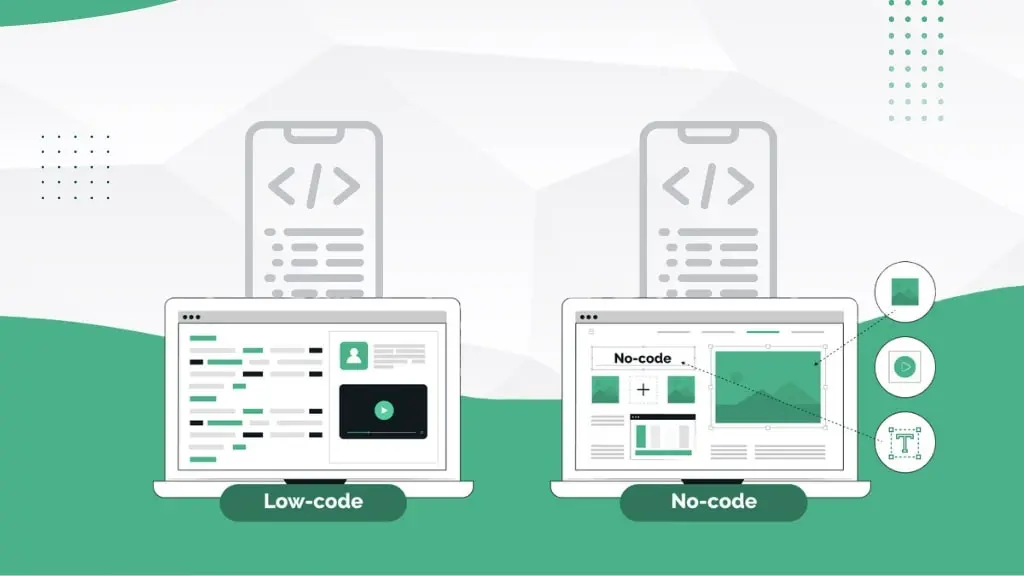Developing a mobile application seems like a daunting task, isn’t it? Well, surely. Having to write complex codes in order to develop a simple app is hard, especially when you are not well-versed in complex coding languages.
But what if you want to create a mobile application without any traditional coding? That’s when low-code and no-code mobile app development comes in!
With advancements in mobile app development, it is now possible for developers (with limited coding experience) to create mobile applications, all thanks to low-code and no-code platforms.
At the moment, low-code and no-code development is on the rise. In fact, the global low-code platform market is expected to reach approximately 65 billion U.S. dollars by 2027! Intrigued? This blog is all about that!
In this blog, we’ll be exploring the world of non-technical mobile app development with no-code and low-code platforms. So, without further ado, let’s get started!
Understanding No-Code and Low-Code Platforms in Mobile App Development
Before diving into the deep insights of low-code and no-code mobile app development, let’s first understand what these platforms are –
What are No-Code Platforms?
No-code platforms are rapid application development (RAD) platforms that allow users to build mobile apps without having to write any programming code. Users can seamlessly create an app through the visual interfaces providing drag-and-drop features.
With no-code platforms’ pre-built templates and easy customization options, users can focus on the design and functionality aspects of the app, rather than investing their time on manual coding. For businesses or entrepreneurs seeking a quick and cost-effective solution, no-code mobile app development is an ideal option, as this strategy doesn’t require any extensive investment in technical resources.
What are Low-Code Platforms?
Low-code platforms are another vital RAD strategy that allows users to create a mobile application with visual interfaces such as drag-and-drop, pull-down menu options, and pre-built templates. However, unlike no-code mobile development, low-code platforms still require a minimal level of manual coding to add complex functionalities.
It is a great option for those who want to speed up their mobile application development process, all while keeping advanced functions in the application. All in all, low-code platforms bring out the best of both worlds by providing ease of use as well as technical customization to create an adept mobile application.
Benefits of No-Code and Low-Code Platforms
Let us move forward to understand the key benefits of no-code platforms and low-code platforms.
- Faster Development: The first and foremost benefit of no-code/ low-code platforms is faster development. As said earlier, pre-built templates and drag-and-drop tools make it quite an easy and quick task for developers.
- Cost-Effective: Imagine having no need to hire an expensive team of developers as all the work can be done by one single developer. Both low-code or no-code mobile app development platforms significantly reduce the cost of mobile application development.
- User-Friendly: As no-code and low-code mobile app development platforms are specially designed for those who aren’t familiar with the complex technicality of mobile application development, they offer an extremely user-friendly interface, allowing easy app creation.
- Customization: Isn’t it great to have a number of pre-built mobile app interface options from which you can choose and customize it as per your application’s specific needs? With low-code and no-code mobile app development platforms, developers can customize their mobile app easily using the drag-and-drop features.
- Easy-to-Update: Mobile applications often require regular updates and new features in order to cope with the trends. Without a doubt, this process requires time and effort when done manually. However, with low-code and no-code mobile app development, new features and updates can be added instantly, all while the app is live.
Don’t Miss:- How to Build an App Like Uber: A Comprehensive Guide
No-Code vs Low-Code: Key Differences
Understanding the difference between no-code and low-code platforms is quite important in choosing the right fit for your mobile development project. Here are some key factors that differentiates no-code and low-code platforms —
| No-Code Platforms | Low-Code Platforms | |
| Code Complexity | As the name suggests, no-code platforms do not require any manual coding and are perfect for non-technical users. | Low-code platforms require some level of coding skills for advanced functionalities. |
| Tool Availability | To make it simple for non-technical developers, no-code platforms offer only pre-built templates and simple drag-and-drop buttons. | Low-code platforms offer developers a number of tools and features to provide advanced customization. |
| Flexibility | As there is a limit to customization options on no-code platforms, it offers relatively less flexibility as compared to low-code platforms. | Low-code platforms offer greater flexibility for customization as developers can also code to meet their specific needs. |
| Popular Real-World Examples | Betty Blocks, Appian and Bubble | Mendix, OutSystems and Microsoft Power Apps |
Potential Drawbacks of No-Code and Low-Code Development
Getting overwhelmed with all the great benefits of no-code and low-code platforms? Let’s acknowledge the potential drawbacks of using these platforms to help you form a firm opinion —
Limited Customization
Sometimes the USP can also be a limitation! As mobile application development on no-code platforms is restricted to pre-built templates and features, developers are not able to create highly customized or complex applications with unique functionalities.
Scalability Issues
In order to make an application ready to scale whenever required, manual coding is essential. As a result, low-code and no-code mobile app development platforms aren’t very reliable when it comes to supporting higher workloads and increased performance.
Security Concerns
There is always a limitation over the backend control when using no-code mobile app development platforms. Therefore, developers may also find it hard to implement strong security protocols in the application. As a result, no-code and low-code platforms aren’t quite reliable for businesses dealing with sensitive data.
Lack of Flexibility for Advanced Customization
low-code and no-code mobile app development platforms lack when it comes to advanced customization or modification of applications. The lack of precise control over the application functionality can restrict the developer to limited customization. Eventually, they may need to use traditional coding to achieve the specific needs.
Must Know:- A Complete Guide to Pharmacy Management Software Development
No-Code and Low-Code App Development Trends
The popularity of low-code and no-code mobile app development platforms continues to grow as businesses seek faster, cost-effective ways to develop apps. Several key trends are shaping the future of these platforms.
The Rise of Citizen Developers
Non-technical people who can develop apps without any knowledge of programming language for coding are known as Citizen Developers. As no-code and low-code platforms continue to gain popularity, there will be a significant rise in citizen developers as well.
Needless to say, IT teams all over the world must be happy as now they don’t have to put their time and effort into basic app development.
Integration with Other Technologies
How great would it be if developers could integrate the functionality of no-code and low-code tools with other revolutionizing technologies such as AI, machine learning, and IoT? Well, sooner or later, that’ll also be a possibility.
The integration of such advanced technology will surely allow developers to create more proficient applications without having advanced coding language.
Improved Security and Governance
While security may be a drawback for low-code and no-code mobile app development platforms, vendors are constantly working on the security aspect of these platforms. It is only a matter of time until we see strict compliance and data protection measures implemented with no-code and low-code platforms.
Integration with Traditional Development Tools
Another major trend to look upon in the future is the integration of traditional development tools with no-code or low-code platforms. This hybrid approach will significantly help developers create more complex applications with greater flexibility and scalability using no-code or low-code platforms. Moreover, it will also be a gate for collaboration between technical and non-technical teams, leading to faster development and improved productivity.
Getting Started with No-Code and Low-Code Mobile App Development
- Identify Your Needs: The very first step to follow when starting with low-code or no-code mobile app development is to understand the core purpose of the app you want to create. Make sure you outline all the key features and functionality you seek in your app. Moreover, understand who your target audience is and what the target market needs are.
- Research and Evaluate Platforms: As the no-code and low-code mobile app development market is on the rise, there is a surge in the number of popular platforms such as Bubble, Adalo, or Glide. Therefore, ensure complete research of the market and carefully compare each platform on ease of use, available templates, pricing, and scalability options to choose the best fit for your project.
- Leverage Free Trials and Tutorials: Before you finalise any low-code or no-code mobile app development platform, it’s always good to run a free trial. Using a free trial not only gives you an idea about the platform but also helps you to get familiarised with the functionalities of the platform.
- Start Small and Scale Up: DO NOT play big directly! Begin your low-code or no-code mobile app development journey by building a basic app that only focuses on essential needs. Later, you can go on to add advanced features to your app.
Related Blog:- Healthcare Mobile App Design: Key Guidelines
The Bottom Line
There you have it – A complete guide on the whats and hows of low-code and no-code mobile app development. We certainly hope that this blog will clear all your doubts regarding low-code and no-code mobile app development.
It goes without saying that it’s just the rise of no-code and low-code platforms; the future must hold many advancements that’ll help us all develop complex mobile apps without any complex coding skills!
Written By
Author's Picks
- Designing for Voice Interfaces: The Future of UX/UI in Mobile Apps
- 28/09/2024
- Top 10 Mobile Usability Issues and Solutions to Fix Them
- 22/08/2024
- Top Strategies To Optimize Mobile App Speed For Better User Retention
- 24/09/2024
Categories
- AI for Startups
- AI in Web Development
- AI Integration
- AI Platforms
- AI Prompt
- AI Tools
- AI Trading Software
- Android App
- Android vs iOS Development
- Angular
- API
- API Development
- App
- app development
- App Idea
- App User Feedback
- Application
- Artificial Intelligence
- Audit Services
- Automotive Industry
- Awards and Recognition
- Business Consulting
- Business Website
- Chatbots
- CRM
- CRM for Financial Advisors
- Custom CRM
- Custom SaaS
- Custom Website
- Customer Service
- dashboard design
- Developing a Mobile App
- Digital Business
- E-commerce
- EMR Integration
- Finance
- Financial Advisors
- Financial Advisors
- GIT
- Health Insurance
- iOS App
- iOS App Development
- IoT Mobile App Development
- IoT Platforms
- IT Audit Services
- IT Consulting
- IT Strategies
- Java Development
- Laravel
- Lean Canvas
- Learning Management System
- Logistics Apps
- Mobile App Development
- MVP
- Native App
- News Aggregator Site
- OTT
- Outsourcing IT
- Payment Gateway
- predictive analysis
- Product Launch Strategy
- Progressive Web App (PWA)
- Prototype
- Recommender Systems
- Ruby
- SaaS
- SaaS Application
- SaaS Business
- SaaS Company
- SaaS Development
- SaaS Product
- SaaS Project
- Sales Funnel
- SEO
- Shopping Cart
- Software Development
- SSL and TLS
- Startup Checklist
- Technology
- Tetradic Color Scheme
- UI/UX Design Company
- Unit Testing
- User Flow
- User Testing
- Web Development
- Web Performance Optimization
- website Maintenance Services
- Website Migration Service
- Website Speed Optimization
- WooCommerce
- WordPress





